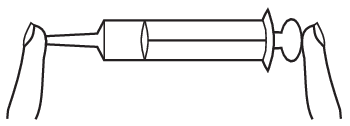 Problem P. 5530. (December 2023)
Problem P. 5530. (December 2023)
P. 5530. The cross sectional area of the piston of a medical syringe is \(\displaystyle 300~\mathrm{mm^2}\) and that of the outlet tube of the syringe is \(\displaystyle 4~\mathrm{mm^2}\). A force of \(\displaystyle 1.4~\mathrm{N}\) is required to move the piston when the device is open (to overcome static friction). After sealing the outlet tube with one finger as shown in the figure, the piston is pushed inwards very slowly with the other finger so that no other part of the syringe is touched (see figure). During the process, the volume of air in the syringe is decreased from \(\displaystyle 20~\mathrm{cm^3}\) to \(\displaystyle 15~\mathrm{cm^3}\).

\(\displaystyle a)\) What is the pressure of the air in the syringe after the piston was pushed to its final position?
\(\displaystyle b)\) At this time, what is the least force at which we have to press the end of the outlet tube of the piston?
(The ambient pressure is 100 kPa, the weight of the syringe is negligible.)
(4 pont)
Deadline expired on January 15, 2024.
Sorry, the solution is available only in Hungarian. Google translation
Megoldás. \(\displaystyle a)\) Ha a levegőt nagyon lassan nyomjuk össze, a hőmérséklete állandó marad, nyomása pedig a folyamat végén a Boyle–Mariotte-törvény szerint:
\(\displaystyle p = 100\,\textrm{kPa}\ \frac{20\,\textrm{cm}^3}{15\,\textrm{cm}^3} = 133\,\textrm{kPa}\)
\(\displaystyle b)\) A fecskendő két végét nyilván ugyanakkora erővel nyomjuk (nem gyorsul). A dugattyú felőli erőt egyszerűbb meghatározni ezért foglalkozzunk azzal! Jelöljük a külső légnyomást \(\displaystyle p_0\)-lal, és a dugattyú keresztmetszetét \(\displaystyle A\)-val. SI mértékegységekben \(\displaystyle p_0=10^5\,\mathrm{Pa}\), \(\displaystyle A=3\cdot 10^{-4}\,\mathrm{m}^2\); a fecskendőben levő levegő nyomása \(\displaystyle \tfrac{4}{3}p_0\).
A dugattyút a levegő minden oldalról nyomja de az eredő nyomóerőt úgy is helyesen megkapjuk, ha csak a \(\displaystyle p_0\)-hoz képesti túlnyomást vesszük figyelembe:
\(\displaystyle \Delta p=\frac{4}{3}\,p_0-p_0=\frac{1}{3}\,p_0\,.\)
A dugattyúra ható, levegő nyomásából származó erő tehát
\(\displaystyle A\,\Delta p =3\cdot 10^{-4}\,\mathrm{m}^2\cdot\frac{1}{3}\cdot 10^5\,\mathrm{Pa}=10\,\mathrm{N}\,.\)
A dugattyú helyben tartásában segít még az \(\displaystyle 1{,}4\,\mathrm{N}\) nagyságú tapadási súrlódási erő, ezért végül csak
\(\displaystyle 10\,\mathrm{N}-1{,}4\,\mathrm{N}=8{,}6\,\mathrm{N}\)
erővel kell a fecskendőt tartanunk.
Megjegyzés. A kivezető csőnél az erő egy részét a cső, másik részét a belül lévő túlnyomásos levegő fejti ki. A kettő együtt éppen kioltja a másik oldalon kifejtett erőt. A kivezető cső belső keresztmetszetére nem volt szükség.
Statistics:
63 students sent a solution. 4 points: Barna Márton, Bunford Luca, Éger Viktória, Fekete Lúcia, Flóring Balázs, Fórizs Borbála, Gerendás Roland, Képes Botond, Molnár Ábel, Molnár Kristóf, Papp András, Sütő Áron, Szabó Donát, Vágó Botond, Zólomy Csanád Zsolt. 3 points: Bélteki Teó, Boér Panna Rita, Erős Fanni, Hornok Máté, Magyar Zsófia, Süveg Janka Villő, Szécsényi-Nagy Rudolf, Tóth Hanga Katalin. 2 points: 28 students. 1 point: 2 students. 0 point: 3 students. Not shown because of missing birth date or parental permission: 1 solutions.
Problems in Physics of KöMaL, December 2023
